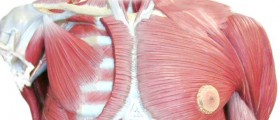
Ataxia telangiectasia, also known as Boder-Sedgwick syndrome or Louis–Bar syndrome, is a rare neurodegenerative and inherited disease responsible for severe disability of affected individuals. This progressive disease affects a number of different organs in the body. It is estimated that it occurs in between 1 out of 40,000 and 1 out of 100,000 persons globally. Ataxia, derived from a Greek word meaning “lack of order”, refers to a lack of coordination of muscle movements, which is characteristic for this disease. Ataxia telangiectasia affects the cerebellum, body’s motor coordination control center, and weakens the patient’s immune system making the body susceptible to diseases.
Causes
Ataxia telangiectasia is an inherited autosomal recessive disease. This means that both parents must provide a defective gene for the child to have symptoms of the disorder. Ataxia telangiectasia is caused by mutations in the ATM gene located on chromosome 11q22-23, which leads to abnormal cell death in various places of the body, including the part of the brain that helps to coordinate movements.
Signs and symptoms
The first symptoms of the disease are visible in the early childhood, when children first develop their locomotion skills. Most commonly, affected children show delayed development of motor skills, poor balance and slurred speech. As the disease progresses, tiny red veins may appear in the corners of the eyes or on the surface of the ears and cheeks. More than a half of all patients with ataxia telangiectasia have immune issues. They are more frequently affected by common colds, bacterial and viral infections. Approximately 20% of all patients will at some point develop cancer, most commonly acute lymphocytic leukemia or lymphoma. Other symptoms include mild diabetes mellitus, premature graying of the hair, difficulty swallowing, and delayed physical and sexual development.
Diagnosis
It may take a couple of years before the ataxia telangiectasia is properly diagnosed in children. Usually, the first signs appear in the early childhood but, as it takes some time before children develop their motor skills, the disease stays undetected for a while. The accurate diagnosis is established based on the laboratory tests for serum AFP levels, the response of white blood cells to X-rays and measurement of the level of ATM protein.
Prognosis
Ataxia telangiectasia is associated with high mortality rates and a shortened life span. Most of the patients with ataxia telangiectasia die before reaching their 20’s. In some rare cases, patients may live to their 40’s. The premature death usually results due to the compromised immune system. Great majority of patients is wheelchair-bound by their teens.
Treatment
There is no known cure for ataxia telangiectasia. The treatment is purely supportive and aimed to decrease the severity of symptoms. Most commonly used treatment is physical and occupational therapy. Speech therapy is used to improve verbal expression and swallowing. Various supplements are also used to support weakened immune system.

















Your thoughts on this
Loading...